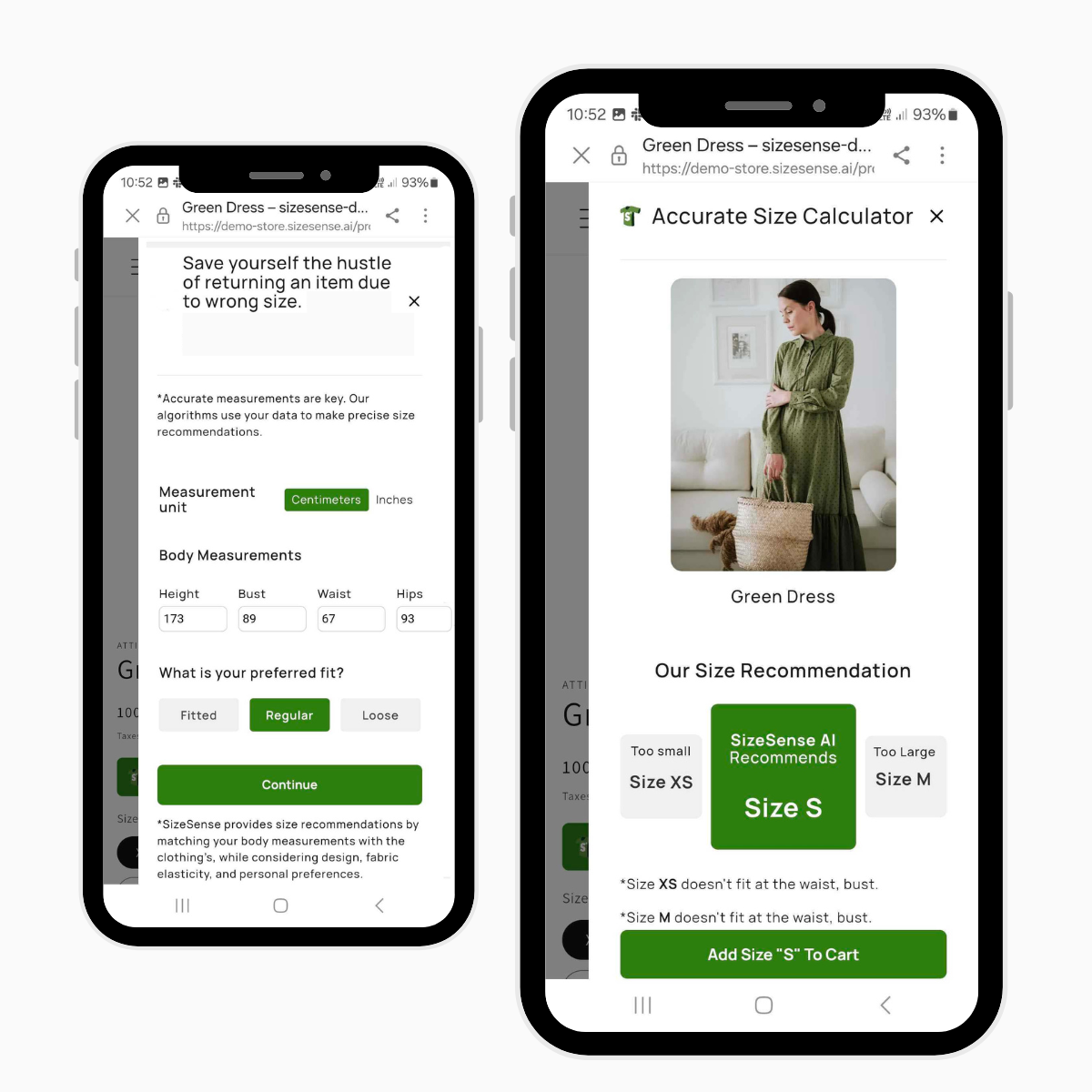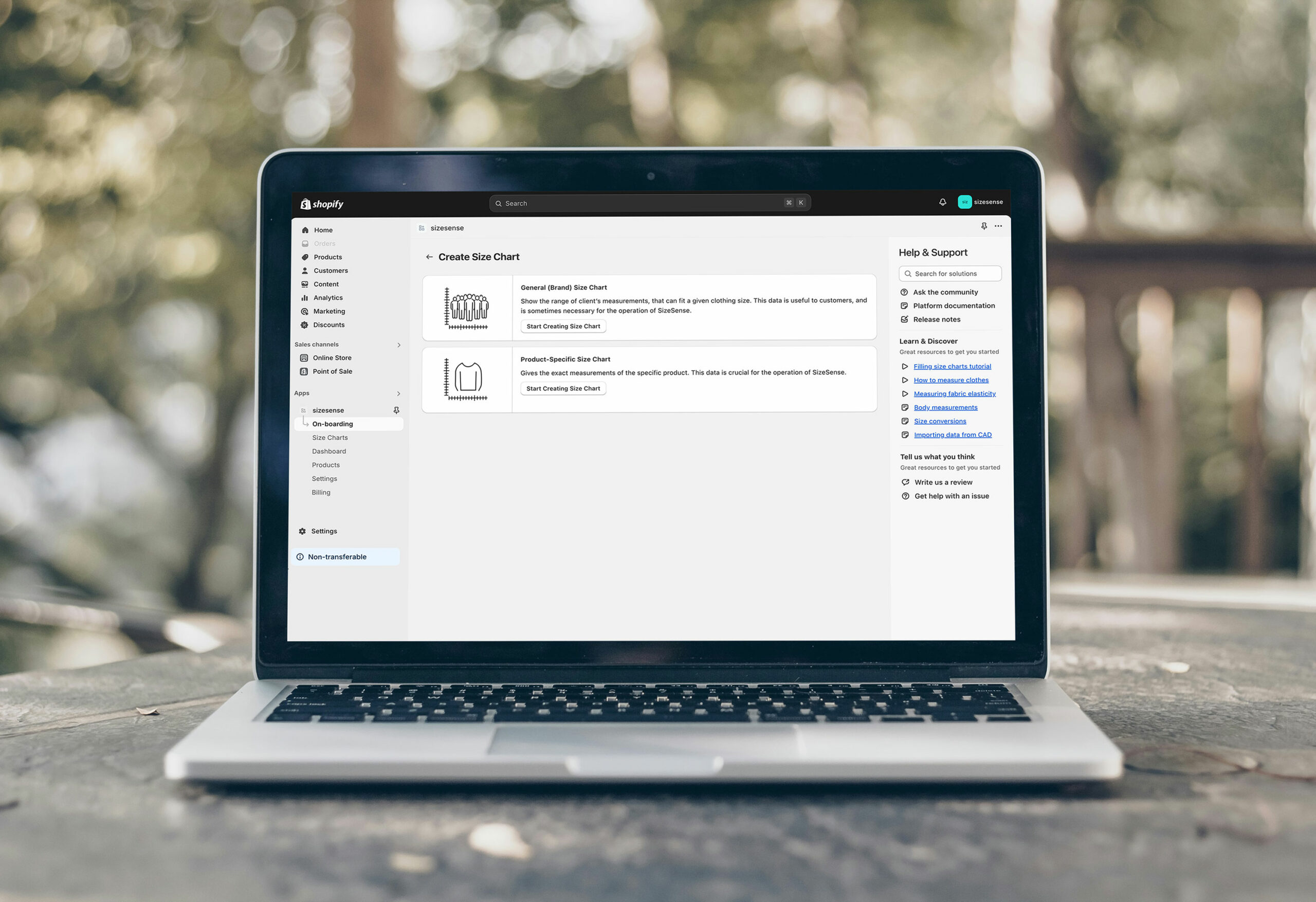Congrats! Your eBook is on its way!
You will receive it in your e-mail in a few minutes… (make sure to check every inbox)

Offer your customers the precise fit they deserve in a hassle-free way with Size Sense
(soon available on Shopify App Store)
The brainchild of an experienced fashion designer/patternmaker and an AI assistant professor. Our size recommending algorithms are the result of crafting hundreds of made-to-measure garments. They achieve precise and personalized fit for every individual.
Reserve a spot on our waitlist and be among the first to get early Access to Size Sense Shopify App!
Finding the perfect clothing size is a daunting task when shopping online
Here is some painful data: 52% of customer returns occur due to sizing issues and 60% of online shoppers hesitate to make a purchase due to sizing uncertainties. When in doubt about the size and fit, customers resort to:
Each of these costs your business money and time. You also lose out on deepening your customer relationships and elevating your brand value.
Reserve a spot on our waitlist and be among the first to get early Access to Size Sense Shopify App!

3 Clear reasons why we’re the best in class
Unmatched Accuracy and Reliability
Adaptability to Different Body Types
Consideration of the Fabric Elasticity
Did you know there’s a new way to:
And all this without:
All this is possible when you use the right Shopify apps for personalized size recommendations
Many fashion brands focus heavily on attracting new customers through marketing and social media. They often overlook the importance of retaining those customers and creating a loyal base.
Instead of fostering long-term relationships, brands often prioritize short-term sales goals. Promotions, coupon codes, or a sense of urgency (usually: highlighting limited stock). On paper, these tactics sound good – they will spur impulse purchases, driven by what we call FOMO (fear of missing out). In reality, they often lead to a fashion brand’s biggest enemy:
Higher return rates and low customer loyalty.
The reason why is quite simple, really. These purchases were not driven by genuine need, interest, or cultivated brand awareness. They were driven by emotion. Once the initial excitement fades, customers experience buyer’s remorse. Soon, returns follow, as well as the risk of diminished customer satisfaction.
Additionally, brands may not invest in personalized shopping experiences, which are crucial for making customers feel valued and understood. When customers don’t feel a connection with a brand or don’t receive a tailored experience, they are less likely to return or remain loyal.
Brands that fail to address these aspects often struggle with inconsistent sales and lower customer retention, even if their products are high-quality and they have a strong online presence.
A robust marketing strategy drives sales and growth. The best Shopify apps are those that help you achieve this with ease.
Example of a successful solution for decreasing return rates and building customer loyalty
The truth is that… most fashion brands struggle with high return rates due to the 3 main reasons why clothing does not fit:
1. Clothes might be the same size, but their pattern is different!
Clothing size depends on both the fit of the clothing and the elasticity of the fabric. People rarely take this detail into consideration when they order clothes online. This intricate combination of factors is one of the main reasons why customers see themselves jumping between different sizes all the time.
2. Clothes might be the same size, but women’s bodies are different!
Even though clothes are labeled with the same size, women’s bodies vary widely in shape and proportions. This means that a size 8 dress might fit well on one woman but be too tight or loose on another due to differences in body shape and design cuts. Inconsistent sizing standards and fabric elasticity further complicate finding the right fit. As a result, customers often struggle to find clothing that suits their unique measurements, leading to frustration and higher return rates.
3. Clothes might be the same size, but the suppliers are different!
Even when clothes are labeled with the same size, the fit can vary significantly because different suppliers use their own sizing standards and patterns. Each brand may have its own interpretation of what a “size 10” should be, leading to inconsistencies in how clothes fit. This discrepancy makes it challenging for customers to find the right size, as they cannot rely on uniform measurements across different brands. Consequently, this variability often results in confusion and frustration for shoppers trying to find clothing that fits well.
When you consider these reasons, it becomes obvious that finding the right clothing size can be a complex and frustrating experience for customers due to inconsistencies in both body shapes and sizing standards across brands. This complexity underscores the need for more reliable and standardized sizing solutions, as well as personalized fitting tools, to personalize shopping experience and reduce the likelihood of returns.
How can I choose the right size recommendation tool?
A glimpse into standard size finder tools
Existing solutions resort to three main methods. Some analyze past customer purchases. Others match size guides across brands. A third group bases recommendations on customer data with similar height and weight profiles.
These methods don’t work for a reason
Past Purchase Analysis assumes past choices reflect current sizing, ignoring changes in body shapes and measurements. It overlooks how fabric elasticity and clothing design affect size.
Brand Size Matching faces inconsistencies in cross-brand sizing and makes accurate matches challenging over time.
Customer Input and Comparison looks appealing on paper. However, it doesn’t ensure accuracy as it’s based solely on height and weight. Individual body shapes and fit preferences remain overlooked, leading to unreliable recommendations.
And now the question is:
“Then which size recommendation tool should I use?”
Let me introduce you to…
Size Sense – The most accurate size recommendation tool is now yours.
Offer your customers the precise fit they deserve in a hassle-free way.
Are you ready to revolutionize your fashion brand’s customer experience? With Size Sense, you can now offer precise size recommendations to your customers, reducing returns and increasing customer loyalty, lifetime customer value and AOV.
Reserve a spot on our waitlist and be among the first to get early Access to Size Sense Shopify App!
Start today, in 3 easy steps!
Sign-up and install
Install our Shopify plugin and create your business account for free.
Upload size charts
Create brand (general) or product (specific) size charts using our intuitive UI. Alternatively, upload your already existing charts.
Configure appearance
Choose how the plugin behaves on your store’s front end and reap the benefits of our algorithms.
Trusted by

Reserve a spot on our waitlist and be among the first to get early Access to Size Sense Shopify App!

My background:
From fashion designer to techpreneur
From a young age, I was captivated by fashion, a passion sparked by my grandmother’s love for a TV series on the industry. Despite my desire to become a fashion designer, I initially pursued Economics due to my parents’ practical concerns. However, I never abandoned my dream and eventually studied fashion design alongside Economics.
I secured a scholarship at Kent State University in Ohio, USA, where I won the prestigious award for “Best Sophomore Design”. It was the first time such an award was given out.
Returning back home, I graduated from both universities. I continued by enrolling in an “Erasmus” exchange program in Spain, focused on fashion design. This was followed by a milestone internship at the prestigious Ilja Visser Group, based in Amsterdam. Once again returning home, I started my own fashion studio.
What I encountered is a common challenge in the fashion industry. One that you will be sure to clash with, too:
Increasing return rates.
Determined to solve this issue, I co-founded Fit+Inch, a startup focused on developing size recommendation algorithms for a B2C fashion marketplace. Despite gaining support from several fashion brands, financial constraints prevented us from fully realizing our vision. In 2022, I made the difficult decision to close my businesses but continued to refine the algorithms with my co-founder, pivoting to a SaaS solution for Shopify.
Now, while working full-time jobs, we dedicate our free time to perfecting our technology, aiming to help fashion brands reduce returns and enhance customer satisfaction.
